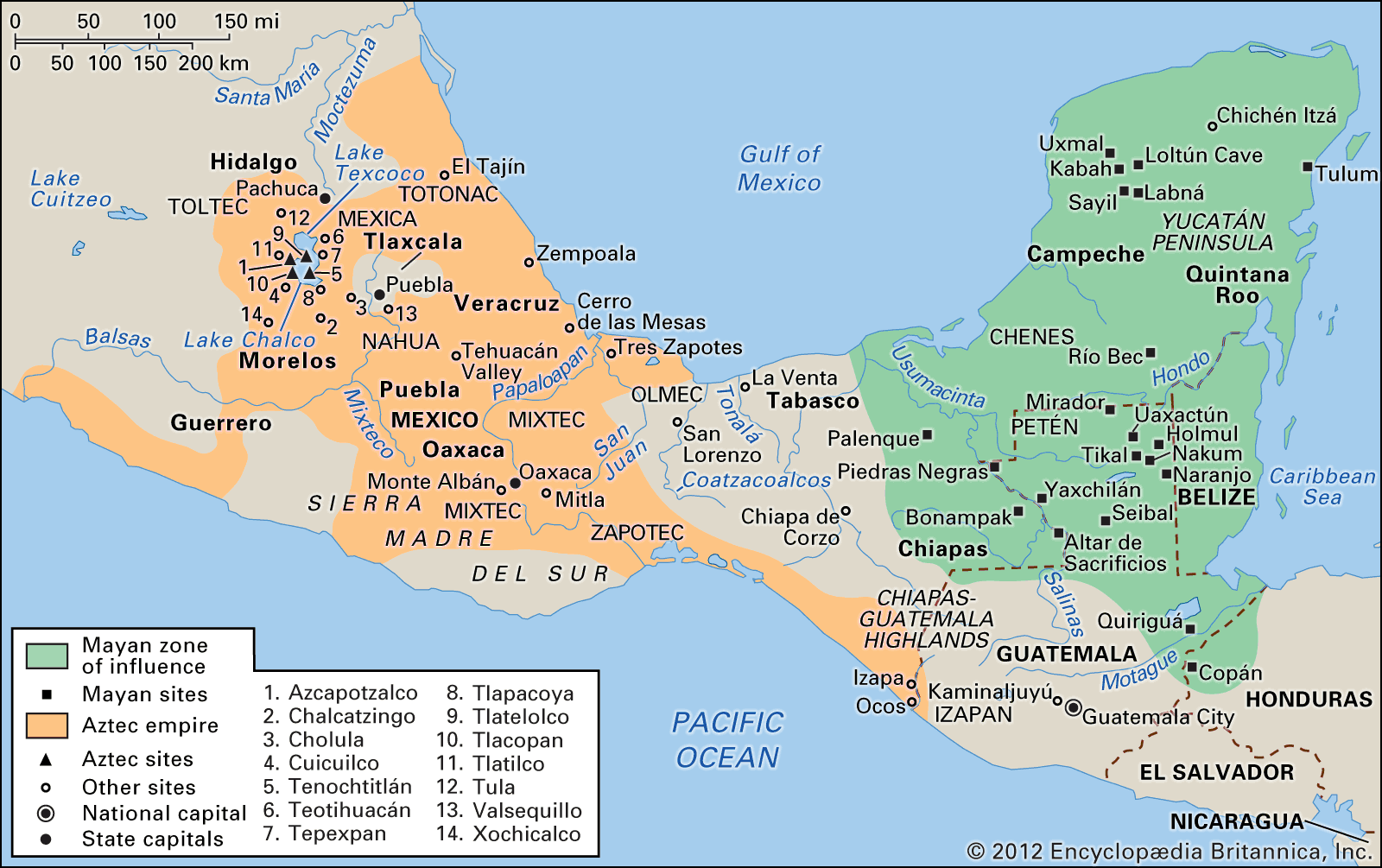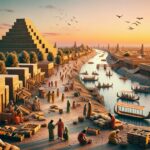Regional States in Ninth- and Tenth-Century Mesoamerica
Mesoamerica, a region brimming with vibrant civilizations, underwent a period of profound transformation during the 9th and 10th centuries. This era witnessed a shift from sprawling empires to smaller, regional states, each vying for power and influence. Unlike modern states with clearly defined borders, these entities were more fluid, exerting control through alliances, trade, and, yes, warfare.
The emergence of these regional states was fueled by a confluence of factors. The diverse landscape, ranging from lush rainforests to arid plateaus, supported a variety of economies and agricultural practices. Surplus food production enabled specialization, with individuals dedicating their time to crafts, religion, and warfare. Innovations like irrigation, metalworking, and writing systems further spurred societal organization and economic growth.
It’s important to remember that these emerging powers weren’t starting from scratch. They inherited a rich legacy from their “prehispanic” predecessors, who had already established social structures, trade routes, and enduring artistic and architectural traditions. This foundation provided a springboard for the innovations and expansions that characterized this era.
Let’s delve into some of the key players who emerged during this time. In central Mexico, the Toltecs rose to prominence, their military might and cultural influence spreading far and wide. Down south, the Mixtec distinguished themselves through their exquisite artistry and unique writing system. Meanwhile, in the Yucatán Peninsula, the Maya city-states flourished, each independent yet interconnected through intricate webs of trade and diplomacy. Known for their advanced understanding of astronomy and complex hieroglyphic writing, the Maya represent a unique facet of Mesoamerican civilization.
The development of these regional states exemplifies the intricate dance between environment, leadership, and cultural exchange that shapes civilizations. By comparing these kingdoms to others around the world, we gain a deeper understanding of both the unique aspects of Mesoamerican history and the broader patterns that connect human civilizations through time. To unlock further insights into this pivotal century, explore the origins of Ireland with our comprehensive guide to who invented Ireland during the ninth century and consult our detailed timeline of the 9th century.
What Defined Regional States in Ninth-and Tenth-Century Mesoamerica?
The 9th and 10th centuries in Mesoamerica were defined by the rise of regional states, a departure from the expansive empires of earlier periods. These states, often centered around dominant cities or alliances, wielded power through a blend of religious authority, economic control, and strategic alliances.
Religion and Politics: Two Sides of the Same Coin
Religion was not merely a matter of faith but a cornerstone of political power and social cohesion within these states. Rituals and ceremonies, often presided over by rulers, served to legitimize authority and foster a sense of collective identity. Think of it as a grand spectacle that reinforced the ruler’s position and connected the people to a shared belief system.
A Tapestry of Power: From City-States to Empires
The Mesoamerican political landscape was anything but uniform. While some states, like the Maya, consisted of independent city-states with their own rulers and customs, others, like the nascent Aztec Empire, were on a trajectory toward broader territorial control. This diversity in political structures highlights the dynamic and multifaceted nature of Mesoamerican civilizations.
Ancient Roots and Olmec Influences
To fully grasp the dynamics of these regional states, we must look back to the Preclassic period. During this era, agriculture took root, villages transformed into complex societies, and the foundations of Mesoamerican culture were laid. Among the early civilizations, the Olmec, with their distinctive art, religious practices, and far-reaching influence, stand out as a major force shaping the trajectory of later Mesoamerican societies.
Kingdoms Rise: The Postclassic Period
Fast-forwarding to the Postclassic period, we witness the emergence of powerful kingdoms like the Mixtec and Zapotec. The Aztecs, rising from humble origins, would eventually become the dominant force in Mesoamerica, building a vast empire through conquest, trade, and strategic alliances.
Summing It All Up
In essence, these regional states were defined by:
- The centrality of religion: It was the bedrock of political power and social unity.
- Diversity and dynamism: Ranging from city-states to nascent empires, Mesoamerica was a patchwork of political structures.
- Ancient legacies: The Preclassic period, particularly the Olmec civilization, exerted a lasting influence on later civilizations.
- Rise of powerful kingdoms: The Postclassic period marked the rise of dominant kingdoms that controlled vast territories and resources.
The Rise and Fall of Major Regional States: Who Were the Key Players?
Just as empires rise, they also fall. The 18th century witnessed the decline of the Mughal Empire in India, creating a power vacuum that ambitious leaders and regional powers were eager to fill. This period saw the emergence of several key players who would shape the political landscape of the Indian subcontinent.
The Marathas, renowned for their military prowess and strategic brilliance, played a pivotal role in this transformation. Their rise to prominence exemplified the shifting balance of power during this era. In Bengal, Alivardi Khan established a powerful and independent state, while the Nawabs of Awadh consolidated their control over the region now known as Uttar Pradesh. Meanwhile, the Nizams of Hyderabad emerged as a formidable force in central India. In the south, Hyder Ali and his son Tipu Sultan transformed Mysore into a prosperous and influential kingdom.
Each of these regional states developed its own distinct character, adopting unique styles of governance, raising armies, and forging alliances. This period was marked by constant competition and shifting allegiances as these new powers vied for dominance. However, this fragmentation also created vulnerabilities. The constant struggles and power vacuums created an opportunity for the British East India Company to exploit these divisions, ultimately leading to British colonial control over India.
The rise and fall of these regional states is a testament to the cyclical nature of power. It highlights the interplay of ambition, opportunity, and the unforeseen consequences of political fragmentation. To delve deeper into this historical period, explore the origins of Ireland with our comprehensive guide to who invented Ireland during the ninth century and consult our detailed timeline of the 9th century.
Citation:
- Richards, J. F. (1995). The Mughal Empire. Cambridge University Press.
How Did These States Interact? Warfare
In the absence of clearly defined borders, interaction between Mesoamerican states was a complex and often tense affair. Warfare, while not constant, played a significant role in shaping the relationships and distribution of power among these regional powers.
Let’s Talk About War
Warfare in Mesoamerica differed significantly from the large-scale conflicts of empires like Rome. It often took the form of strategic raids, alliances aimed at weakening rivals, and attempts to capture valuable resources or high-status individuals. Armies, while not as massive as those of later empires, were nevertheless well-equipped and strategically deployed. Weapons ranged from the commonplace (spears, bows and arrows, clubs) to ingenious innovations designed to gain an edge in battle. Fortifications, often massive and complex structures, played a vital role in defending key cities and resources.
It Wasn’t Always About Brute Force
Warfare in Mesoamerica was not solely about military might. Ritual and tradition played a significant role, with battles often adhering to specific customs and beliefs. Victories were attributed to divine favor, and conflicts were sometimes seen as a means of settling disputes within a framework of ritualistic combat.
So, What Was the Point of All This Fighting?
The motivations behind these conflicts were often rooted in:
- Control over land and resources: More land equated to greater agricultural output and access to valuable resources, essential for population growth and economic prosperity.
- Power dynamics: Warfare was often a tool for rulers to assert dominance, expand their influence, and enhance their prestige.
- Revenge and retribution: Grudges and historical grievances often fueled conflicts that could span generations.
The Aftermath
The consequences of warfare could be far-reaching, leading to:
- Shifting borders: Victors often absorbed territories from defeated rivals, redrawing the political map.
- Forced relocations: Populations were sometimes forcibly moved to weaken enemies or provide labor for the victors.
- New alliances (and new enemies): Warfare often forged new alliances while solidifying existing rivalries, perpetuating cycles of conflict.
The Bottom Line
Warfare was an intrinsic element of the Mesoamerican world, shaping relationships, redefining political boundaries, and leaving an enduring mark on the region’s history and culture.
- Unlock Filipino Culture: A Deep Dive into Traditions and Practices - April 23, 2025
- Unlock Spanish Culture: Insights & Opportunities Now - April 23, 2025
- White Spirit Uses & Substitutes: A Deep Dive for Pros & DIYers - April 23, 2025
















